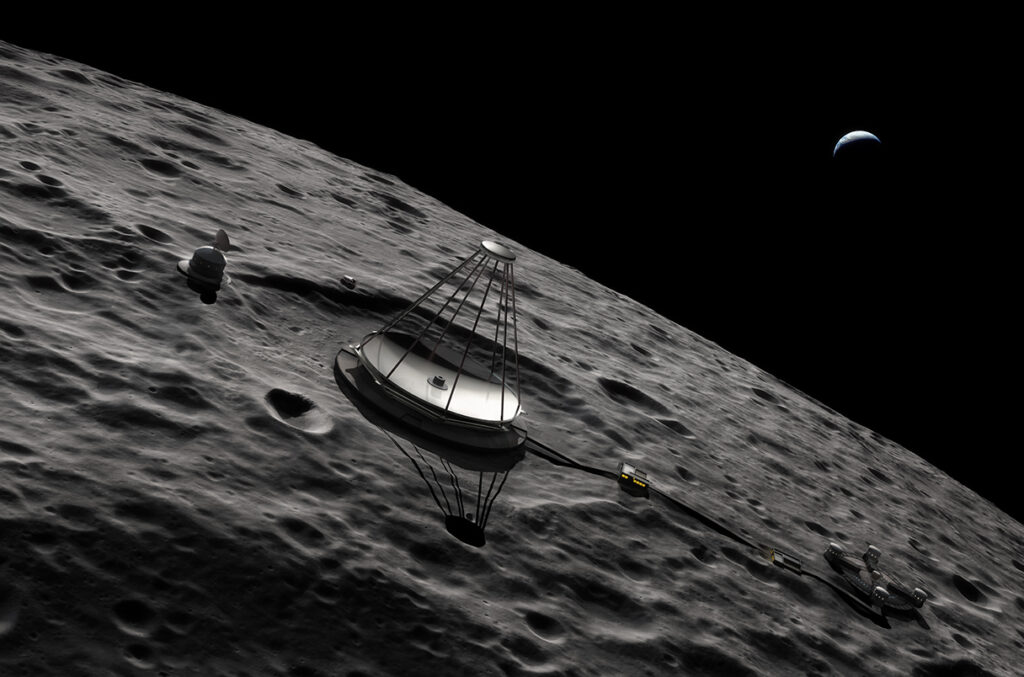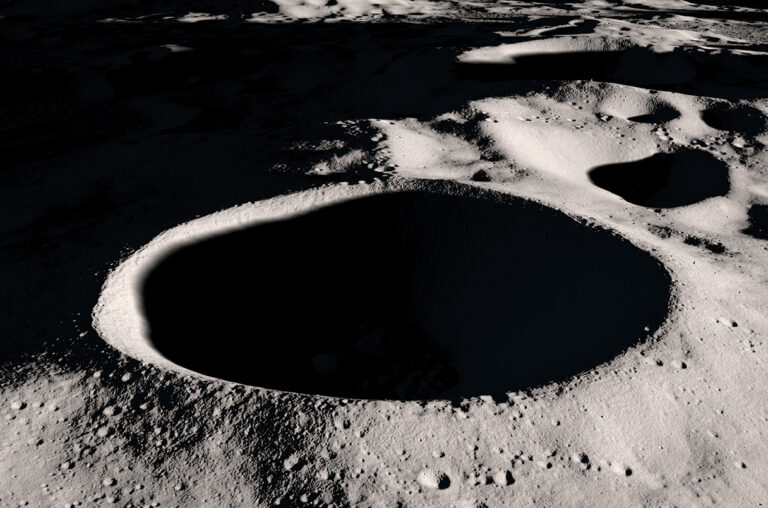Scientifically Significant Locations on the Moon at Risk of Permanent Loss Amidst Mining Frenzy
Researchers are actively pursuing measures to safeguard the untouched regions on the far side of the Moon as well as its polar regions.
Science and commerce are on a collision course in an unexpected location: the Moon. After a hiatus of fifty years, NASA is preparing to launch Peregrine Mission 1, a lander developed by the private company Astrobotic Technology, to the lunar surface by the end of this year. This will be followed by numerous other missions, including those under NASA’s Artemis program aimed at returning astronauts to the Moon. While most scientists anticipate a new era of exploration and scientific breakthroughs, there are concerns looming.
Experts predict that the arrival of private landers will trigger a “Moon rush,” as companies compete to exploit valuable minerals and resources, potentially disregarding scientifically significant lunar sites. As space law currently offers limited or no protection to these areas, researchers are actively advocating for governments and international organizations to take action before irreversible damage occurs.
“This is an urgent matter,” emphasizes astronomer Richard Green from the University of Arizona, who is establishing a working group within the International Astronomical Union (IAU) to address lunar site preservation. Astrophysicist Martin Elvis from the Center for Astrophysics | Harvard & Smithsonian has also been drawing attention to this issue. “We must emphasize the exceptional nature of these sites. They could be lost forever,” he warns.
Numerous lunar missions, both public and private, are anticipated to land in the near future with the objective of discovering resources that could potentially sustain astronauts or be commercially mined and brought back to Earth. These resources include rare-earth elements and helium-3, which could be utilized in theoretical fusion reactors. NASA’s Artemis program explicitly promotes the exploitation of lunar resources and has already awarded contracts to four companies in 2020 for the collection of lunar material.
However, scientists express concerns that such mining activities could pose a threat to unique areas like the craters near the north or south pole, which are permanently shadowed. These craters have interiors that remain consistently below –225°C, making them the coldest locations in the entire Solar System. Orbiting probes have revealed that these frigid depths contain substantial reserves of ice, potentially accumulated over billions of years as water was transported by asteroids from the outer regions of the Solar System. If this is the case, these craters hold an invaluable record of the delivery of water to Earth.
Furthermore, permanently shadowed craters serve as ideal sites for space-based infrared telescopes that require extreme cold temperatures for their operation. The recently launched James Webb Space Telescope (JWST) necessitates a large sunshield and a cryocooler to maintain the cold temperature of its 6.5-meter mirror and instruments as it orbits the Sun. However, within a deep lunar crater, a much larger telescope, possibly spanning 100 meters, would naturally remain cool without any assistance. Such a telescope would possess exceptional vision capabilities to study the surfaces of Earth-like planets orbiting other stars. Jan Harms from the Gran Sasso Science Institute, who envisions constructing the Lunar Gravitational-wave Antenna in a seismically tranquil shadowed crater, emphasizes the Moon’s uniqueness, stating, “I’m not aware of any other body in the Solar System with these characteristics.”
However, these deep and mysterious craters, along with the water they hold, will undoubtedly become a primary focus for individuals planning an extended stay on the Moon. In addition to serving as a vital source of drinking water, the ice within these craters could be utilized to produce oxygen for life support and hydrogen for rocket fuel, making the surrounding areas an ideal location for establishing a Moon base. Nevertheless, this pursuit comes at a cost, as it would result in the loss of invaluable scientific research opportunities. Paul Hayne, a planetary scientist from the University of Colorado Boulder, and his colleagues have emphasized the importance of allowing scientists sufficient time to study the ice before any extraction activities commence. Furthermore, the mining process itself could generate vibrations that would interfere with the detection of gravitational wave signals and stir up fine particles of lunar dust, potentially damaging telescope mirrors.

Radio astronomers are keen to establish a new zone on the far side of the Moon, shielded from the interference of radio signals emitted by Earth-based transmitters. They envision the installation of large radio dishes and arrays of antennas spanning hundreds of kilometers, which would enable them to detect the faint hiss of neutral hydrogen gas that existed before the formation of the first stars. By studying the disappearance of this gas, which was ionized by starlight, astronomers can observe the birth of the earliest galaxies.
However, the tranquility of this pristine radio environment is already at risk. Space agencies and companies are planning to deploy fleets of satellites in lunar orbit to assist rovers on the Moon’s surface and transmit data back to Earth. Although efforts are being made to avoid interfering with radio frequencies or turning off satellites when passing over telescopes, unintentional emissions from onboard electronics could still be detected. As a result, the regulations set by the International Telecommunication Union (ITU) to safeguard the far side of the Moon as a “radio quiet zone” may need to be revised, according to Alanna Krolikowski, a political scientist from the Missouri University of Science and Technology.
The 1967 Outer Space Treaty prohibits nations from claiming territorial rights over celestial bodies, but it does not address the issue of space mining, which was purely speculative at the time. Some countries, including the United States, argue that resource extraction does not equate to asserting sovereignty, drawing a parallel with fishing in international waters without claiming ownership. To support this perspective, the 2015 SPACE Act explicitly permits U.S. companies to extract and profit from resources obtained in space.
While NASA’s Artemis Accords, a set of exploration guidelines endorsed by 31 other countries, do offer protection for historical artifacts such as the Apollo landing sites and emphasize a commitment to maintaining a sustainable space environment, they do not explicitly safeguard areas of scientific significance.
The Committee on the Peaceful Uses of Outer Space, a part of the United Nations, could offer additional guidance in this matter. Elvis and Krolikowski, in a forthcoming paper in the Philosophical Transactions of the Royal Society A, argue that the U.N. committee has the potential to designate lunar sites of exceptional scientific significance. However, Krolikowski acknowledges that the U.N. operates on long-term time frames.
Telescope builders are relying on the International Astronomical Union (IAU) to present their case. Led by Green, the working group will convene for the first time on 27 November. Their primary objective is to define the issue at hand, such as identifying the specific sites that require protection and determining the level of radio interference that could be detrimental to telescopes on the far side of the Moon. “We need clear criteria for evaluation,” emphasizes Green. “We require a platform to assert our claims, have them thoroughly considered, and then accept the outcome.”
Scientists are optimistic about the return of space agencies to the Moon, seeing it as an opportunity for significant advancements. “I believe that the majority of planetary scientists perceive these launch projects as favorable prospects,” states Parvathy Prem from Johns Hopkins University. However, Krolikowski expresses concern that the pursuit of resources should not overshadow the potential for scientific exploration. “Deep down, everyone recognizes the value of protecting science,” she asserts. “Short-term interests should not take precedence.”
Do not forget to share your opinion with us to provide you with the best posts !




0 Comments